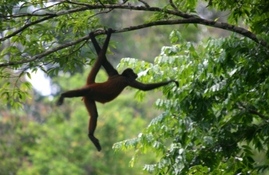Locomotion
Lemurs are found on the island of Madagascar. The island has a very harsh climate, it is a very unpredictable place to live. Sometimes there will be long periods of drought and other times there will be excessive flooding due to cyclones. Madagascar is composed of rain forests and dry forests. Due to the climate there is many species of lemurs that have adapted to live successfully in the different parts of the island. Locomotion in lemurs varies a lot because of the diversity of the species. However, the locomotion of these animals can be put into two main groups. There are lemurs who are vertical clingers and those who leap. Depending on their environment lemurs will use one or the other form of locomotion. Lemurs use their strong back legs to vertically jump from tree to tree, when the next tree is to far to jump to then the lemurs climb to the ground and leap sideways on two legs until they get to the next tree and can climb up it.

Spider Monkeys live in the tropical rain forests of central and South America. They spend most of their time in trees and prefer to thrive in areas with a canopy over them. Scientists have taken note of several locomotion patterns in spider monkeys. The three main types of locomotion they use are quadrupedal, suspensory, and bipedalism. In quadrupedal locomotion they use all four limbs to walk or run. In suspensory locomotion is when they hang, climb, or glide from tree to tree. Bipedalism is when they use two limbs to leap, walk, or run. The type of locomotion they choose is based on their environment. They mostly use suspensory locomotion when they are in an area with a lot of trees close together. When they need to move in an area with less trees however, they must use another form of locomotion.

Baboons live in Africa or Arabia. They prefer to live in the savannah or other partially-arid climates. This means that baboons spend most of their time living on the ground. The locomotion exhibited by baboons is quadrupedal which means they walk on all fours. The reason they do this is because of their environment. They usually live in open areas and must walk from place to place. Unlike some primates baboons don't swing from tree to tree they use their four legs to walk around because the areas they inhabit have little to no trees.
Gibbons live in rain forests in southern Asia. For the most part they live in trees. The forests they like to live in are dense with a lot of trees. The type of locomotion these animals use is called branchiating which is an extreme form of suspensory locomotion. They also have been seen walking on branches or on the ground on two legs which is called bipedalism, but branchiating is their main form of locomotion. They gracefully swing from tree to tree using this skill. Their specific environment of dense trees is the reason they developed this form of locomotion. Unlike the baboons who walk on all fours because they live in open areas, gibbons swing from tree to tree because they live in dense areas.

Chimpanzees can inhabit African rain forests, woodlands, and grasslands. They exhibit three forms of locomotion because of their diverse environment. They walk on all fours, which is quadrupedal locomotion. They swing in trees which is suspensory locomotion. As well as being able to walk on two feet which is bipedal locomotion. Their environment enables them to use all of these forms of locomotion because it is diverse.
In conclusion, after researching all of these animals I realize that environment plays a key role in what type of locomotion a certain species displays. Animals who live in areas without lots of trees such as baboons use quadrupedal locomotion because they don't need the skill of suspensory locomotion, their environment does not call for it. Animals who live in denser areas such as gibbons lemurs and spider monkeys rely mostly on suspensory locomotion because of their tree filled environment. Animals who live in diverse environments with areas with trees and flat areas such as the chimpanzee rely on multiple forms of locomotion to be able to navigate their environment. So, the environment an animal lives in forces the animal to adapt to a specific form of locomotion. You wouldn't need to swing from tree to tree if you are a baboon who lives on the open planes of the savannah. Also you wouldn't have to spend much time walking on all fours or on two legs if you are a gibbon because your environment makes it necessary to swing from tree to tree.










